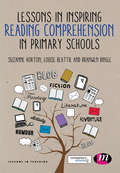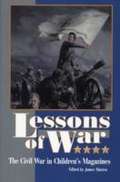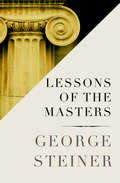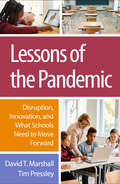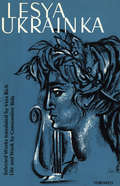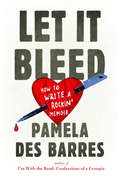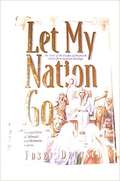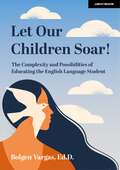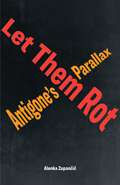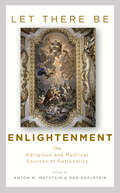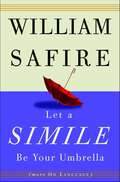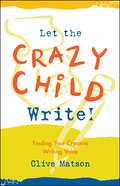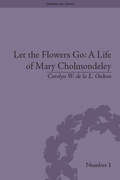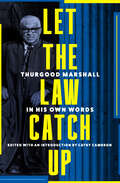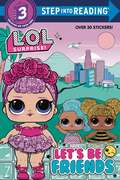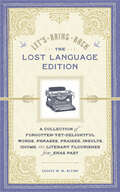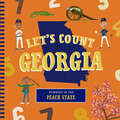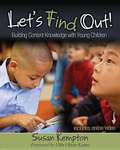- Table View
- List View
Lessons in Teaching Reading Comprehension in Primary Schools (Lessons in Teaching)
by Ms Suzanne Horton Ms Branwen Bingle Louise BeattieLesson planning in line with the new Primary National Curriculum! Why do we teach children to read? It is not merely to decode the words. We teach them to derive meaning from the text, to comprehend it. To not just read the lines, but to read between the lines and even read beyond the lines. So how can you make teaching comprehension in primary schools effective and engaging? How are you ensuring that children are finding meaning in what they read and how do we support more able readers to learn more? What does a good 'reading' lesson look like? This book demonstrates the effective teaching of reading through exemplar lessons. It discusses what makes them good lesson plans and how they can be adapted to suit different classes and different schools. In particular, this book helps you to meet the needs of more able readers particularly in years 5 and 6, outlining ways to challenge more able pupils to support them with the level 6 tests in Year 6. It helps you to cultivate your subject knowledge and invigorate your classroom teaching through focusing on what children need to learn and how to teach it. Did you know that this book is part of the Lessons in Teaching series? WHAT IS THE LESSONS IN TEACHING SERIES? Suitable for any teacher at any stage of their career, the books in this series are packed with great ideas for teaching engaging, outstanding lessons in your primary classroom. The Companion Website accompanying the series includes extra resources including tips, lesson starters, videos and Pinterest boards. Visit www.sagepub.co.uk/lessonsinteaching Books in this series: Lessons in Teaching Grammar in Primary Schools, Lessons in Teaching Computing in Primary Schools, Lessons in Teaching Number and Place Value in Primary Schools, Lessons in Teaching Reading Comprehension in Primary Schools, Lesson in Teaching Phonics in Primary Schools
Lessons of War: The Civil War in Children's Magazines
by James Alan MartenWhile information regarding children and their outlook on the war is not abundant, James Marten, through extensive research, has uncovered essays, editorials, articles, poems, games, short stories and letters that tell the story of the Civil War through the eyes of the children living then.
Lessons of the Masters (The\charles Eliot Norton Lectures #51)
by George SteinerA thought-provoking examination of the complex teacher-student relationship, from one of the great minds of the modern literary worldBased on George Steiner&’s extensive experience as a teacher, Lessons of the Masters is a passionate examination of the &“profession of the professor.&” He writes about what empowers one person to teach another, and explores the complexities and nuances of this bond. From the charismatic master to the loving disciple, Steiner explores the religious, philosophical, economic, and scientific aspects of imparting knowledge, drawing upon history&’s most famous teachers: Socrates, Jesus, Faust, Virgil, Dante, Heloise, and Abelard.
Lessons of the Pandemic: Disruption, Innovation, and What Schools Need to Move Forward
by David T. Marshall Tim PressleyThe impacts of the COVID-19 pandemic on K–12 education have been pervasive and profound. This engaging book concisely outlines the current crisis in schools in the core areas of student learning, student and teacher mental health, and teacher burnout. Synthesizing original research, David T. Marshall and Tim Pressley offer in-depth descriptions of the disruptions caused by prolonged school closures and remote instruction. They also identify some positive changes, such as increased use of online resources and technology, flexible work models, and greater attention to social and emotional learning. Sharing key findings, concrete examples, and teachers&’ own voices about what they need to succeed, the book provides clear recommendations for moving schools forward effectively and sustainably.
Lessons on the English Verb
by Walter HirtleGuillaume's theory of psychomechanics views language as systematic and semiotic, with the use of verb forms governed by the meaning we want to express, which is embedded in the unconscious resources of one's native tongue rather than in rules. Through his application of Guillaume's framework Walter Hirtle provides original insights on such topics as the treatment of the progressive and the perfect in English, the use of 'do' as an auxiliary in questions and negations, and tense and its relation to aspect and mood. Hirtle is the former director of the Fonds Gustave Guillaume, an archive of 60,000 manuscript pages of the theorist's work, housed at Laval University, the world centre for the study of psychomechanics.
Lesya Ukrainka
by Vera Rich Constantine BidaThe Ukrainian national poetess Lesya Ukrainka (1871-1913) has contributed greatly to the development of Ukrainian Modernism and its transition from Ukrainian ethnographic themes to subjects that were universal, historical and psychological. Breaking the thematic conventions of populist literature, she sought difficult and complex motifs and gave them original treatment: themes such as the revolutionary ideological conflicts of the seventeenth and eighteenth centuries, which appear in some of her later poetry, are strengthened, given greater impact by her method of applying the individual and the personal to the more general concepts.From the beginning of her career her poetry was characterized by the theme of the poet's vocation and by the motifs connected with it--loneliness and alienation from society. Associated motifs deal with her love of freedom (national freedom in particular) and her hatred of anything weak and undecided.This book, sponsored by the Women's Council of the Ukrainian Canadian Committee, is a discussion of her life and works and includes selected translations: Robert Bruce (1903), Cassandra (1907), The Orgy (1913), The Stone Host (1912), and "Contra spem spero." Readers interested in development of poetic style can study the gradual evolution from the lyrical to the precise and analytical manner of the prose-poems of Lesya Ukrainka, and discover the thematic wealth, depth of thought, and emotional power of her poetry.
Let It Bleed: How to Write a Rockin' Memoir
by Pamela Des BarresAuthor of the international bestseller I'm with the Band: Confessions of a Groupie, Pamela Des Barres shares with women the art of memoir writing.For the last fourteen years, Pamela Des Barres has been teaching an eight-week women's "femoir" writing workshop. She found that the music-loving ladies who showed up at her door had pent-up stories to tell. Many of them had read her two memoirs, which were wildly personal and deeply confessional, and felt comfortable opening up and experiencing that same freedom of expression. In this book, Des Barres guides women through the process of writing their memoirs. She has developed exercises to help her "dolls" recall, remember, relive, and reveal their memories, transgressions, temptations, their sleepless nights and brilliant afternoons, loves and losses, fears and regrets, secrets, sins, and sorrows. The assignments in Femoir have proven incredibly cathartic for her students. Just as intimate as one of her in-person workshops, this book includes some of Des Barres's own stories, as well as those of the women she's taught. Every person has an incredible story to tell—they just need to figure out how to tell it. By understanding themselves better through these writing exercises, women learn to be more fearless, free-spirited, and willing to try something new.
Let My Nation Go
by Yosef DeutschWhen it comes to the most dramatic event in history to epitomize a nation's transition from slavery to freedom, no story captures the world s imagination more than the Jewish nation's exodus from Egypt. And to tell that amazing story, there is no book that captures it all the ancient setting, the vast scope, the grand themes, the memorable personalities along with the details of those events better than Let My Nation Go. The author draws upon a wealth of traditional sources along with a rich array of classic commentaries, and then weaves it all together to create a seamless narrative that reads like an exciting novel. This is history on a grand scale; the stirring story of the birth of the Jewish nation: from the roots of their arrival in Egypt, through centuries of suffering, through the ten plagues, leading up to that epic moment known as the Exodus. Written with compelling insight, historical precision, and narrative flair, Let My Nation Go brings the birth of the Jewish nation vividly to life. It will forever change the way you view this momentous chapter in the unfolding history of the world.
Let Our Children Soar! The Complexity and Possibilities of Educating the English Language Student
by Bolgen Vargas Ed.D.This is a story about English language learners - one in particular - and a reflection on what we, as educators, can do to promote their success.As educators, we're faced every day with the question of how to teach the thousands - many thousands - of children who arrive in our schools as immigrants and refugees, coming with no English, from cultural backgrounds so different from America's, often from impoverished households and often from households where education of the kind we know was completely absent.Our work as educators is to help these children start to climb the wall that stands between their past, wherever and however that was lived, and a future in America, where their education will prepare them to take advantage of the same opportunities everyone else here enjoys.This is not an easy job. But it's one we can't afford to get wrong. And this is not a small corner in our education system today. The number of English language learners in U.S. school systems is large and growing. And the educators involved in teaching this exceptional population include basically everyone, not just those teachers with direct classroom contact. When they're in the building, the entire school is the English language learner's world.
Let Our Children Soar! The Complexity and Possibilities of Educating the English Language Student
by Bolgen Vargas Ed.D.This is a story about English language learners - one in particular - and a reflection on what we, as educators, can do to promote their success.As educators, we're faced every day with the question of how to teach the thousands - many thousands - of children who arrive in our schools as immigrants and refugees, coming with no English, from cultural backgrounds so different from America's, often from impoverished households and often from households where education of the kind we know was completely absent.Our work as educators is to help these children start to climb the wall that stands between their past, wherever and however that was lived, and a future in America, where their education will prepare them to take advantage of the same opportunities everyone else here enjoys.This is not an easy job. But it's one we can't afford to get wrong. And this is not a small corner in our education system today. The number of English language learners in U.S. school systems is large and growing. And the educators involved in teaching this exceptional population include basically everyone, not just those teachers with direct classroom contact. When they're in the building, the entire school is the English language learner's world.
Let Them Rot: Antigone’s Parallax (Idiom: Inventing Writing Theory)
by Alenka ZupančičA provocative, highly accessible journey to the heart of Sophocles’ Antigone elucidating why it keeps resurfacing as a central text of Western thought and Western culture.There is probably no classical text that has inspired more interpretation, critical attention, and creative response than Sophocles’ Antigone. The general perspective from which the book is written could be summarized with this simple question: What is it about the figure of Antigone that keeps haunting us? Why do all these readings and rewritings keep emerging? To what kind of always contemporary contradiction does the need, the urge to reread and reimagine Antigone—in all kinds of contexts and languages—correspond? As key anchor points of this general interrogation, three particular “obsessions” have driven the author’s thinking and writing about Antigone. First is the issue of violence. The violence in Antigone is the opposite of “graphic” as we have come to know it in movies and in the media; rather, it is sharp and piercing, it goes straight to the bone. It is the violence of language, the violence of principles, the violence of desire, the violence of subjectivity. Then there is the issue of funerary rites and their role in appeasing the specific “undeadness” that seems to be the other side of human life, its irreducible undercurrent that death alone cannot end and put to rest. This issue prompted the author to look at the relationship between language, sexuality, death, and “second death.” The third issue, which constitutes the focal point of the book, is Antigone’s statement that if it were her children or husband lying unburied out there, she would let them rot and not take it upon herself to defy the decree of the state. The author asks, how does this exclusivist, singularizing claim (she would do it only for Polyneices), which she uses to describe the “unwritten law” she follows, tally with Antigone’s universal appeal and compelling power? Attempting to answer this leads to the question of what this particular (Oedipal) family’s misfortune, of which Antigone chooses to be the guardian, shares with the general condition of humanity. Which in turn forces us to confront the seemingly self-evident question: “What is incest?”Let Them Rot is Alenka Zupančič’s absorbing and succinct guided tour of the philosophical and psychoanalytic issues arising from the Theban trilogy. Her original and surprising intervention into the broad and prominent field of study related to Sophocles’ Antigone illuminates the classical text’s ongoing relevance and invites a wide readership to become captivated by its themes.
Let There Be Enlightenment: The Religious and Mystical Sources of Rationality
by Edited by Anton M. Matytsin and Dan EdelsteinChallenging the triumphalist narrative of Enlightenment secularism.According to most scholars, the Enlightenment was a rational awakening, a radical break from a past dominated by religion and superstition. But in Let There Be Enlightenment, Anton M. Matytsin, Dan Edelstein, and the contributors they have assembled deftly undermine this simplistic narrative. Emphasizing the ways in which religious beliefs and motivations shaped philosophical perspectives, essays in this book highlight figures and topics often overlooked in standard genealogies of the Enlightenment. The volume underscores the prominent role that religious discourses continued to play in major aspects of seventeenth- and eighteenth-century thought. The essays probe a wide range of subjects, from reformer Jan Amos Comenius’s quest for universal enlightenment to the changing meanings of the light metaphor, Quaker influences on Baruch Spinoza’s theology, and the unexpected persistence of Aristotle in the Enlightenment. Exploring the emergence of historical consciousness among Enlightenment thinkers while examining their repeated insistence on living in an enlightened age, the collection also investigates the origins and the long-term dynamics of the relationship between faith and reason. Providing an overview of the rich spectrum of eighteenth-century culture, the authors demonstrate that religion was central to Enlightenment thought. The term "enlightenment" itself had a deeply religious connotation. Rather than revisiting the celebrated breaks between the eighteenth century and the period that preceded it, Let There Be Enlightenment reveals the unacknowledged continuities that connect the Enlightenment to its various antecedents.Contributors: Philippe Buc, William J. Bulman, Jeffrey D. Burson, Charly Coleman, Dan Edelstein, Matthew T. Gaetano, Howard Hotson, Anton M. Matytsin, Darrin M. McMahon, James Schmidt, Céline Spector, Jo Van Cauter
Let Us Make Men: The Twentieth-Century Black Press and a Manly Vision for Racial Advancement
by D'Weston HaywoodDuring its golden years, the twentieth-century black press was a tool of black men's leadership, public voice, and gender and identity formation. Those at the helm of black newspapers used their platforms to wage a fight for racial justice and black manhood. In a story that stretches from the turn of the twentieth century to the rise of the Black Power movement, D'Weston Haywood argues that black people's ideas, rhetoric, and protest strategies for racial advancement grew out of the quest for manhood led by black newspapers. This history departs from standard narratives of black protest, black men, and the black press by positioning newspapers at the intersections of gender, ideology, race, class, identity, urbanization, the public sphere, and black institutional life. Shedding crucial new light on the deep roots of African Americans' mobilizations around issues of rights and racial justice during the twentieth century, Let Us Make Men reveals the critical, complex role black male publishers played in grounding those issues in a quest to redeem black manhood.
Let Us Watch Richard Wilbur: A Biographical Study
by Robert Bagg Mary BaggPulitzer Prize–winning poet Richard Wilbur (b. 1921) is part of a notable literary cohort, American poets who came to prominence in the mid-twentieth century. Wilbur's verse is esteemed for its fluency, wit, and optimism; his ingeniously rhymed translations of French drama by Molière, Racine, and Corneille remain the most often staged in the English-speaking world; his essays possess a scope and acumen equal to the era's best criticism. This biography examines the philosophical and visionary depth of his world-renowned poetry and traces achievements spanning seventy years, from political editorials about World War II to war poems written during his service to his theatrical career, including a contentious collaboration with Leonard Bernstein and Lillian Hellman. Wilbur's life has been mistakenly seen as blessed, lacking the drama of his troubled contemporaries. Let Us Watch Richard Wilbur corrects that view and explores how Wilbur's perceived "normality" both enhanced and limited his achievement. The authors augment the life story with details gleaned from access to his unpublished journals, family archives, candid interviews they conducted with Wilbur and his wife, Charlee, and his correspondence with Robert Lowell, Elizabeth Bishop, John Berryman, John Malcolm Brinnin, James Merrill, and others.
Let a Simile Be Your Umbrella
by William SafireCollection of On Language columns from the New York Times Sunday magazine. Safire's observations on language usage are always useful and sometimes amusing.
Let the Crazy Child Write!: Finding Your Creative Writing Voice
by Clive MatsonTwelve lively, in-depth chapters reveal how following our untrained impulses — our creative unconscious or "Crazy Child" — gives an authentic grasp on writing stories, poems, plays, and essays. Let the Crazy Child Write! introduces exercises that explicitly tap this knowledge and also presents guidelines on how to give, and receive, constructive feedback. This is the first how-to-write text to give full credit to the creative unconscious since Becoming a Writer, the 1934 classic by Dorothea Brande. Matson goes further by developing writing techniques step by step: Image Detail, Slow Motion, Hook, Persona Writing, Point of View, Dialogue, Plot, Narrative Presence, Good Clichés, Character, Surrealism, and Resolution.
Let the Flowers Go: A Life Of Mary Cholmondeley (Gender and Genre #1)
by Carolyn W OultonGiving a comprehensive critique of Cholmondeley's writings, Oulton analyzes the inspiration and influences behind some of her greatest work and provides an appealing biography on a writer whose work is of increasing interest to modern scholars.
Let the Law Catch Up: Thurgood Marshall in His Own Words
by Cathy CambronA collection of US Supreme Court Justice Thurgood Marshall&’s legal writings spanning his career, including his arguments, opinions, and dissents. The US Constitution promised much to Black citizens with its post–Civil War amendments designed to eliminate the stigma of slavery and create equality between all races, but unfortunately it delivered little justice. Thurgood Marshall spent his life working to make the Constitution live up to its promises. In the 1940s and &’50s, Marshall worked as an attorney for the National Association for the Advancement of Colored People (NAACP), facing threats and harassment as he argued cases before the Supreme Court. His efforts culminated in the Brown v. Board of Education case, where the Supreme Court&’s ruling outlawed &“separate but equal&” public schools. After serving as a judge for the US Court of Appeals and as the first Black US solicitor general, Marshall became the nation&’s first Black Supreme Court Justice in 1967. Marshall believed the Constitution was a living document and a work in progress, and his career and legacy demonstrate it is indeed just that. Only through struggle, suffering, sacrifice, amendment, argument, and interpretation can the Constitution be made better. Marshall committed decades of his life to this effort, focused on his vision of what America could be. Let the Law Catch Up collects Justice Marshall&’s words from over the course of his career, from his advocacy with the NAACP to his arguments as solicitor general and his Supreme Court opinions and dissents. With introductions providing historical and legal context, this book paints a powerful portrait of a fearless man and his life&’s work.
Let's Be Friends: L.O.L. Surprise! (Step into Reading #3)
by B. B. ArthurMeet Queen Bee, Miss Punk, Sugar Queen, and all of your favorite L.O.L. Surprise!TM fierce friends! This Step 3 Step into Reading leveled reader has over 30 outrageous L.O.L. Surprise!TM stickers--perfect for boys and girls ages 5 to 8! Step 3 readers feature engaging characters in easy-to-follow plots about popular topics. For children who are ready to read on their own. In a world where babies run everything, little Rockers rebel against nap time and Teacher's Pets become class presidents with "Free Pizza Fridays!" In the L.O.L. Surprise! TM world, all work is play and nothing is dull cuz it's all a lil' surprising and outrageous!
Let's Bring Back: A Collection of Forgotten-Yet-Delightful Words, Phrases, Praises, Insults, Idioms, and Literary Flourishes from Eras Past
by Lesley M. BlumeAn A-to-Z reference featuring wonderful words and expressions from the past: “What a fun book!” —Kathleen Dunn, Wisconsin Public RadioHistory is positively brimming with rich language deserving of rejuvenation. This compendium gathers forgotten words, phrases, names, insults, and idioms, plus fascinating and funny anecdotes, etymologies, and occasions for modern use. Let’s Bring Back: The Lost Language Edition takes readers on a philological journey through words from the not-too-distant past. From all-overish to zounds, the vintage vernacular collected here will make any reader the cat’s meow among friends, relations, and acquaintances.
Let's Count Georgia
by Christopher Robbins1 green jacket at the Masters won 2 favorite players hit a home run 3 pretty dogwoods in springtime bloom 4 Civil War cannons sound a boom Numbers and colors are more fun in Georgia! In this dynamic, colorful primer, young readers count from 1 to 10—learning colors along the way—as they discover the places, animals, and other wonderful things that make Georgia so unique.
Let's Eat Grandma: Everything You Need to Know About Grammar
by Joanne Adamshttp://www.stisonbooks.com/images/books/native/9781786851451
Let's Find Out!: Building Content Knowledge with Young Children
by Susan KemptonIn her new book, Let’s Find Out!, kindergarten teacher Susan Kempton talks about the importance of helping children build the content knowledge that is critical to educational success. She shows how she capitalizes on children’s natural curiosity and uses various tools—literature (particularly nonfiction), visuals, living and nonliving artifacts, drawing, song, movement, dramatization—to develop language, concepts, and basic literacy skills. As their foundation becomes richer, children’s talk, writing, and options for reading expand and flourish
Let's Go Shopping: A Grammar Tales Book To Support Grammar And Language Development In Children (Grammar Tales)
by Jessica HabibPete and Jem are very helpful at the supermarket, but end up causing chaos with a tower of food on display. Targeting Subject-Verb-Object sentences and the conjunction ‘and’ for listing, this book provides repeated examples of early developing syntax and morphology which will engage and excite the reader while building pre-literacy skills and make learning fun, as well as exposing children to multiple models of the target grammar form. Perfect for a speech and language therapy session, this book is an ideal starting point for targeting client goals and can also be enjoyed at school or home to reinforce what has been taught in the therapy session.
